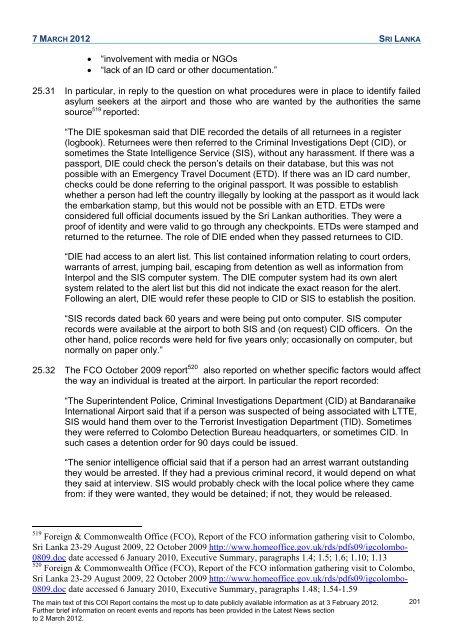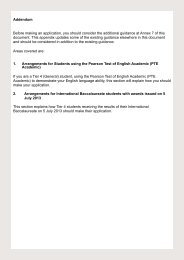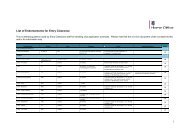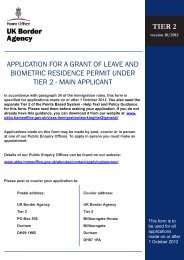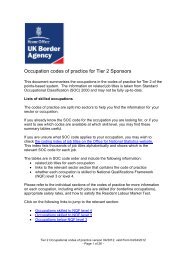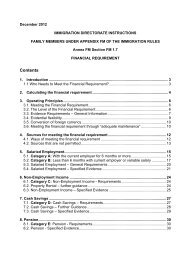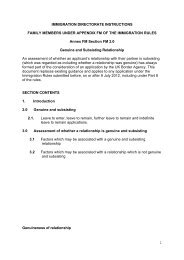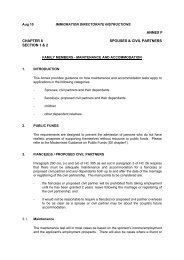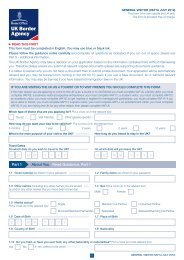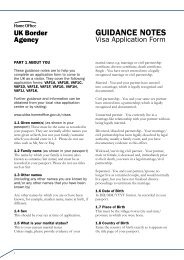COI Report March 2012 - UK Border Agency - Home Office
COI Report March 2012 - UK Border Agency - Home Office
COI Report March 2012 - UK Border Agency - Home Office
You also want an ePaper? Increase the reach of your titles
YUMPU automatically turns print PDFs into web optimized ePapers that Google loves.
7 MARCH <strong>2012</strong> SRI LANKA<br />
� ―involvement with media or NGOs<br />
� ―lack of an ID card or other documentation.‖<br />
25.31 In particular, in reply to the question on what procedures were in place to identify failed<br />
asylum seekers at the airport and those who are wanted by the authorities the same<br />
source 519 reported:<br />
―The DIE spokesman said that DIE recorded the details of all returnees in a register<br />
(logbook). Returnees were then referred to the Criminal Investigations Dept (CID), or<br />
sometimes the State Intelligence Service (SIS), without any harassment. If there was a<br />
passport, DIE could check the person‘s details on their database, but this was not<br />
possible with an Emergency Travel Document (ETD). If there was an ID card number,<br />
checks could be done referring to the original passport. It was possible to establish<br />
whether a person had left the country illegally by looking at the passport as it would lack<br />
the embarkation stamp, but this would not be possible with an ETD. ETDs were<br />
considered full official documents issued by the Sri Lankan authorities. They were a<br />
proof of identity and were valid to go through any checkpoints. ETDs were stamped and<br />
returned to the returnee. The role of DIE ended when they passed returnees to CID.<br />
―DIE had access to an alert list. This list contained information relating to court orders,<br />
warrants of arrest, jumping bail, escaping from detention as well as information from<br />
Interpol and the SIS computer system. The DIE computer system had its own alert<br />
system related to the alert list but this did not indicate the exact reason for the alert.<br />
Following an alert, DIE would refer these people to CID or SIS to establish the position.<br />
―SIS records dated back 60 years and were being put onto computer. SIS computer<br />
records were available at the airport to both SIS and (on request) CID officers. On the<br />
other hand, police records were held for five years only; occasionally on computer, but<br />
normally on paper only.‖<br />
25.32 The FCO October 2009 report 520 also reported on whether specific factors would affect<br />
the way an individual is treated at the airport. In particular the report recorded:<br />
―The Superintendent Police, Criminal Investigations Department (CID) at Bandaranaike<br />
International Airport said that if a person was suspected of being associated with LTTE,<br />
SIS would hand them over to the Terrorist Investigation Department (TID). Sometimes<br />
they were referred to Colombo Detection Bureau headquarters, or sometimes CID. In<br />
such cases a detention order for 90 days could be issued.<br />
―The senior intelligence official said that if a person had an arrest warrant outstanding<br />
they would be arrested. If they had a previous criminal record, it would depend on what<br />
they said at interview. SIS would probably check with the local police where they came<br />
from: if they were wanted, they would be detained; if not, they would be released.<br />
519 Foreign & Commonwealth <strong>Office</strong> (FCO), <strong>Report</strong> of the FCO information gathering visit to Colombo,<br />
Sri Lanka 23-29 August 2009, 22 October 2009 http://www.homeoffice.gov.uk/rds/pdfs09/igcolombo-<br />
0809.doc date accessed 6 January 2010, Executive Summary, paragraphs 1.4; 1.5; 1.6; 1.10; 1.13<br />
520 Foreign & Commonwealth <strong>Office</strong> (FCO), <strong>Report</strong> of the FCO information gathering visit to Colombo,<br />
Sri Lanka 23-29 August 2009, 22 October 2009 http://www.homeoffice.gov.uk/rds/pdfs09/igcolombo-<br />
0809.doc date accessed 6 January 2010, Executive Summary, paragraphs 1.48; 1.54-1.59<br />
The main text of this <strong>COI</strong> <strong>Report</strong> contains the most up to date publicly available information as at 3 February <strong>2012</strong>.<br />
Further brief information on recent events and reports has been provided in the Latest News section<br />
to 2 <strong>March</strong> <strong>2012</strong>.<br />
201


